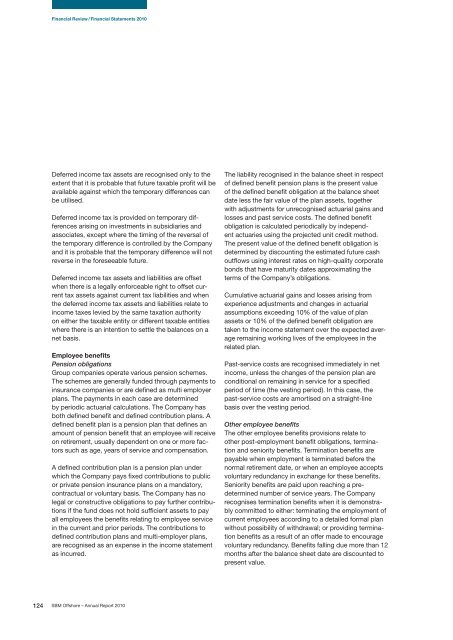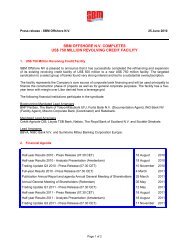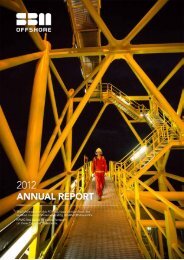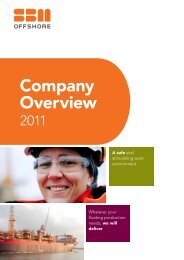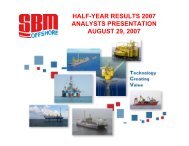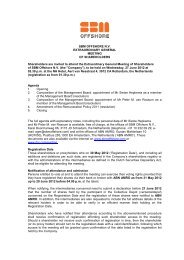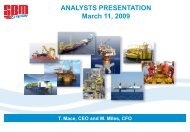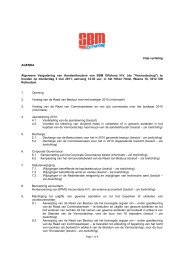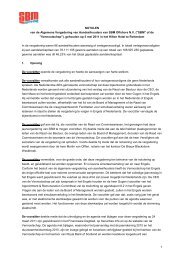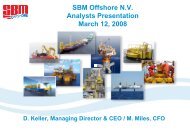Annual Report 2010 - SBM Offshore
Annual Report 2010 - SBM Offshore
Annual Report 2010 - SBM Offshore
You also want an ePaper? Increase the reach of your titles
YUMPU automatically turns print PDFs into web optimized ePapers that Google loves.
Financial Review / Financial Statements <strong>2010</strong><br />
Deferred income tax assets are recognised only to the<br />
extent that it is probable that future taxable profit will be<br />
available against which the temporary differences can<br />
be utilised.<br />
Deferred income tax is provided on temporary differences<br />
arising on investments in subsidiaries and<br />
associates, except where the timing of the reversal of<br />
the temporary difference is controlled by the Company<br />
and it is probable that the temporary difference will not<br />
reverse in the foreseeable future.<br />
Deferred income tax assets and liabilities are offset<br />
when there is a legally enforceable right to offset current<br />
tax assets against current tax liabilities and when<br />
the deferred income tax assets and liabilities relate to<br />
income taxes levied by the same taxation authority<br />
on either the taxable entity or different taxable entities<br />
where there is an intention to settle the balances on a<br />
net basis.<br />
Employee benefits<br />
Pension obligations<br />
Group companies operate various pension schemes.<br />
The schemes are generally funded through payments to<br />
insurance companies or are defined as multi employer<br />
plans. The payments in each case are determined<br />
by periodic actuarial calculations. The Company has<br />
both defined benefit and defined contribution plans. A<br />
defined benefit plan is a pension plan that defines an<br />
amount of pension benefit that an employee will receive<br />
on retirement, usually dependent on one or more factors<br />
such as age, years of service and compensation.<br />
A defined contribution plan is a pension plan under<br />
which the Company pays fixed contributions to public<br />
or private pension insurance plans on a mandatory,<br />
contractual or voluntary basis. The Company has no<br />
legal or constructive obligations to pay further contributions<br />
if the fund does not hold sufficient assets to pay<br />
all employees the benefits relating to employee service<br />
in the current and prior periods. The contributions to<br />
defined contribution plans and multi-employer plans,<br />
are recognised as an expense in the income statement<br />
as incurred.<br />
124 <strong>SBM</strong> <strong>Offshore</strong> – <strong>Annual</strong> <strong>Report</strong> <strong>2010</strong><br />
The liability recognised in the balance sheet in respect<br />
of defined benefit pension plans is the present value<br />
of the defined benefit obligation at the balance sheet<br />
date less the fair value of the plan assets, together<br />
with adjustments for unrecognised actuarial gains and<br />
losses and past service costs. The defined benefit<br />
obligation is calculated periodically by independent<br />
actuaries using the projected unit credit method.<br />
The present value of the defined benefit obligation is<br />
determined by discounting the estimated future cash<br />
outflows using interest rates on high-quality corporate<br />
bonds that have maturity dates approximating the<br />
terms of the Company’s obligations.<br />
Cumulative actuarial gains and losses arising from<br />
experience adjustments and changes in actuarial<br />
assumptions exceeding 10% of the value of plan<br />
assets or 10% of the defined benefit obligation are<br />
taken to the income statement over the expected average<br />
remaining working lives of the employees in the<br />
related plan.<br />
Past-service costs are recognised immediately in net<br />
income, unless the changes of the pension plan are<br />
conditional on remaining in service for a specified<br />
period of time (the vesting period). In this case, the<br />
past-service costs are amortised on a straight-line<br />
basis over the vesting period.<br />
Other employee benefits<br />
The other employee benefits provisions relate to<br />
other post-employment benefit obligations, termination<br />
and seniority benefits. Termination benefits are<br />
payable when employment is terminated before the<br />
normal retirement date, or when an employee accepts<br />
voluntary redundancy in exchange for these benefits.<br />
Seniority benefits are paid upon reaching a predetermined<br />
number of service years. The Company<br />
recognises termination benefits when it is demonstrably<br />
committed to either: terminating the employment of<br />
current employees according to a detailed formal plan<br />
without possibility of withdrawal; or providing termination<br />
benefits as a result of an offer made to encourage<br />
voluntary redundancy. Benefits falling due more than 12<br />
months after the balance sheet date are discounted to<br />
present value.


